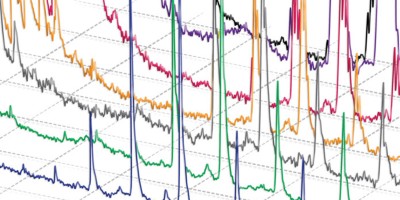Abstract
We describe here a protocol for determining the activity of protein kinases on a large set of peptide substrates. Biotin-tagged peptides are arrayed in multiwell plates and incubated in solution with the kinase of interest and radiolabeled ATP. Reactions are then spotted simultaneously onto a streptavidin membrane, which is washed, dried, and analyzed by autoradiography or phosphor imaging. Differences in the extent of radiolabel incorporation into the various peptide substrates provide a measure of the sequence specificity of the kinase. This approach is a faster, more sensitive, and more generally applicable method for determining kinase phosphorylation motifs than older peptide library screening approaches based on Edman sequencing. The procedure is readily adaptable to other applications that require parallel processing of many kinase reactions, such as screening for small molecule inhibitors. In the format described here, preparation of stock plates prior to running the reactions will require about 4 days. Afterwards, the protocol takes approximately 6 hours to perform.

Similar content being viewed by others
References
Hutti, J. E. et al. A rapid method for determining protein kinase phosphorylation specificity. Nat. Meth. 1, 27–29 (2004).
Songyang, Z. et al. Use of an oriented peptide library to determine the optimal substrates of protein kinases. Curr. Biol. 4, 973–982 (1994).
Asensio, C. J. A. and Garcia, R. C. Determination of a large number of kinase activities using peptide substrates, P81 phosphocellulose paper arrays and phosphor imaging. Anal. Biochem. 319, 21–33 (2003).
Fujii, K. et al. Kinase peptide specificity: improved determination and relevance to protein phosphorylation. Proc. Natl. Acad. Sci. USA 101, 13744–13749 (2004).
Rodriguez, M., Li, S.S., Harper, J.W. & Songyang, Z. An oriented peptide array library (OPAL) strategy to study protein-protein interactions. J. Biol. Chem. 279, 8802–8807 (2004).
Rychlewski, L. et al. Target specificity analysis of the Abl kinase using peptide microarray data. J. Mol. Biol. 336, 307–311 (2004).
Bantan-Polak, T. et al. A comparison of fluorescamine and naphthalene-2,3-dicarboxaldehyde fluorogenic reagents for microplate-based detection of amino acids. Anal. Biochem. 297, 128–136 (2001).
Acknowledgements
This work was supported by National Institutes of Health grant GM56203 (to L.C.C) and a fellowship from the Leukemia and Lymphoma Society (to B.E.T.).
Author information
Authors and Affiliations
Corresponding author
Ethics declarations
Competing interests
The authors declare no competing financial interests.
Supplementary information
Rights and permissions
About this article
Cite this article
Turk, B., Hutti, J. & Cantley, L. Determining protein kinase substrate specificity by parallel solution-phase assay of large numbers of peptide substrates. Nat Protoc 1, 375–379 (2006). https://doi.org/10.1038/nprot.2006.57
Published:
Issue Date:
DOI: https://doi.org/10.1038/nprot.2006.57
- Springer Nature Limited
This article is cited by
-
Regulation of folate and methionine metabolism by multisite phosphorylation of human methylenetetrahydrofolate reductase
Scientific Reports (2019)
-
Amperometric determination of the activity of protein kinase a using a glassy carbon electrode modified with IgG functionalized gold nanoparticles conjugated to horseradish peroxidase
Microchimica Acta (2017)
-
Csk-homologous kinase (Chk) is an efficient inhibitor of Src-family kinases but a poor catalyst of phosphorylation of their C-terminal regulatory tyrosine
Cell Communication and Signaling (2017)




